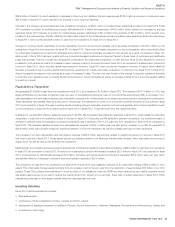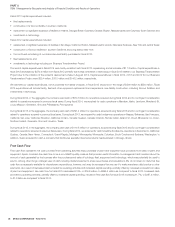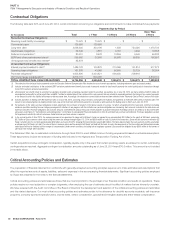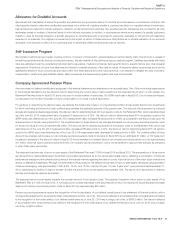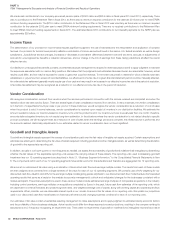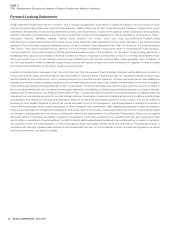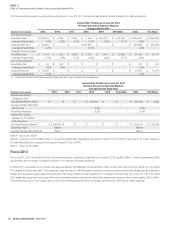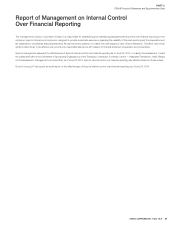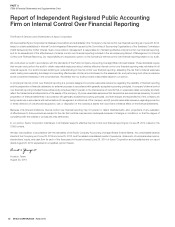Sysco 2014 Annual Report Download - page 55
Download and view the complete annual report
Please find page 55 of the 2014 Sysco annual report below. You can navigate through the pages in the report by either clicking on the pages listed below, or by using the keyword search tool below to find specific information within the annual report.SYSCO CORPORATION-Form10-K 43
PARTII
ITEM7Management’s Discussion and Analysis ofFinancial Condition and Results of Operations
of assessment in scal 2014, 2013 or 2012. Our past estimates of fair value for scal 2013 and 2012 have not been materially different when revised to
include subsequent years’ actual results. Sysco has not made any material changes in its impairment assessment methodology during the past three
scal years. We do not believe the estimates used in the analysis are reasonably likely to change materially in the future but we will continue to assess
the estimates in the future based on the expectations of the reporting units. In the scal 2014 assessment, our estimates of fair value did not require
additional analysis. However, we would have performed additional analysis to determine if an impairment existed for our Caribbean Broadline, European
Broadline and Sysco Ventures reporting units if our estimates of fair value were decreased by 11% to 23%. As of June 28, 2014, these reporting units
had goodwill aggregating $275.5 million. For the remainder of our reporting units, which as of June 28, 2014 had goodwill aggregating $1.7 billion, we
would have performed additional analysis to determine if an impairment existed for a reporting unit if the estimated fair value for any of these reporting
units had declined by greater than 25%.
Certain reporting units (Caribbean Broadline, European Broadline, specialty produce, custom-cut meat, lodging industry products, imported specialty
products, international distribution operations and our Sysco Ventures platform) have a greater proportion of goodwill recorded to estimated fair value as
compared to the U.S. Broadline, Canada Broadline or SYGMA reporting units. This is primarily due to these businesses having been more recently acquired,
and as a result there has been less history of organic growth than in the U.S. Broadline, Canadian Broadline and SYGMA reporting units. In addition, these
businesses also have lower levels of cash ow than the U.S. Broadline reporting unit. As such, these reporting units have a greater risk of future impairment
if their operations were to suffer a signi cant downturn.
Share-Based Compensation
Sysco provides compensation bene ts to employees and non-employee directors under several share-based payment arrangements including various
employee stock option plans, a non-employee director plan and the Employees’ Stock Purchase Plan.
As of June 28, 2014, there was $64.9 million of total unrecognized compensation cost related to share-based compensation arrangements. That cost is
expected to be recognized over a weighted-average period of 2.39 years.
The fair value of each option award is estimated on the date of grant using a Black-Scholes option pricing model. Expected volatility is based on historical
volatility of Sysco’s stock, implied volatilities from traded options on Sysco’s stock and other factors. We utilize historical data to estimate option exercise
and employee termination behavior within the valuation model; separate groups of employees that have similar historical exercise behavior are considered
separately for valuation purposes. Expected dividend yield is estimated based on the historical pattern of dividends and the average stock price for the year
preceding the option grant. The risk-free rate for the expected term of the option is based on the U.S. Treasury yield curve in effect at the time of grant.
The fair value of each restricted stock unit award granted with a dividend equivalent is based on the company’s stock price as of the date of grant. For
restricted stock units granted without dividend equivalents, the fair value is reduced by the present value of expected dividends during the vesting period.
The fair value of the stock issued under the Employee Stock Purchase Plan is calculated as the difference between the stock price and the employee
purchase price.
The fair value of restricted stock granted to employees or non-employee directors is based on the stock price on grant date. The application of a discount
to the fair value of a restricted stock grant is dependent upon whether or not each individual grant contains a post-vesting restriction.
The compensation cost related to these share-based awards is recognized over the requisite service period. The requisite service period is generally the
period during which an employee is required to provide service in exchange for the award. The compensation cost related to stock issuances resulting
from employee purchases of stock under the Employees’ Stock Purchase Plan is recognized during the quarter in which the employee payroll withholdings
are made.
Our share-based awards are generally subject to graded vesting over a service period. We will recognize compensation cost on a straight-line basis over
the requisite service period for the entire award.
In addition, certain of our share-based awards provide that the awards continue to vest as if the award holder continued to be an employee or director if
the award holder meets certain age and years of service thresholds upon retirement. In these cases, we will recognize compensation cost for such awards
over the period from the grant date to the date the employee or director rst becomes eligible to retire with the options continuing to vest after retirement.
Our option grants include options that qualify as incentive stock options for income tax purposes. In the period the compensation cost related to incentive
stock options is recorded, a corresponding tax bene t is not recorded as it is assumed that we will not receive a tax deduction related to such incentive
stock options. We may be eligible for tax deductions in subsequent periods to the extent that there is a disqualifying disposition of the incentive stock
option. In such cases, we would record a tax bene t related to the tax deduction in an amount not to exceed the corresponding cumulative compensation
cost recorded in the nancial statements on the particular options multiplied by the statutory tax rate.




